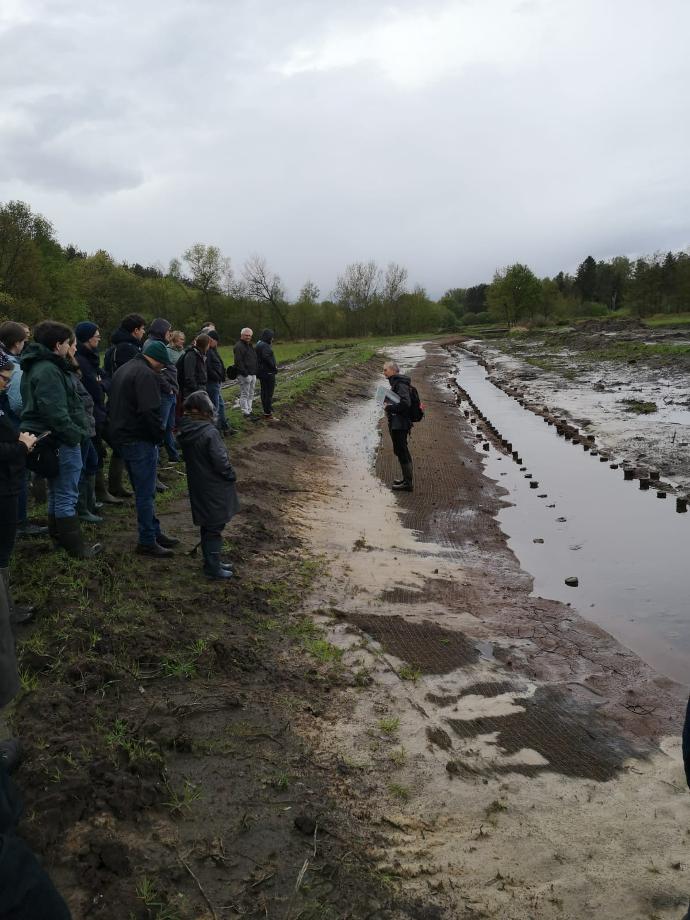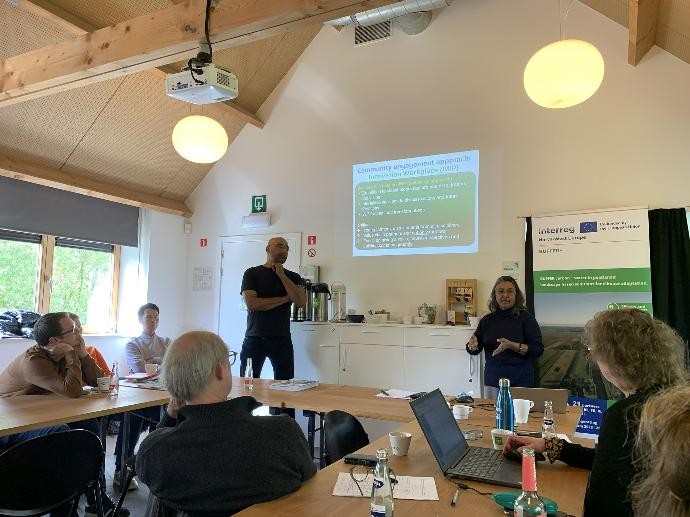On the 17th and 18th of April, partners of the BUFFER+ project convened in Belgium for the partner meeting, which served as a forum for collaborative exchange and shared learning. From wetland restoration projects to engaging with local communities, the partners learned a lot of the practices in Flanders, and in the other regions. You can read more about the two days together, in this article.
Interreg Admire
The partner meeting of BUFFER+ in Belgium began with an engaging presentation by the Interreg Admire project, which aims to restore peatlands in the Flemish-Dutch region. Their work closely aligns with one of BUFFER+'s key areas.

The BUFFER+ partners found themselves intrigued by the collaborative efforts with farmers in places like De Zegge, exploring alternative land management practices while searching for necessary funding. This sparked discussions on potential applications of similar methods.
Private landowner
Following the presentation, the partners ventured to visit Alan Phillips, a local landowner in the Malesbroek - Scherpenbergloop-de Hutten area, who owns 20 hectares of land. Alan graciously hosted them and shared insights into his sustainable land management practices. His emphasis on the value of local knowledge over relying solely on models resonated strongly with the partners.


Visitors centre Grote Netewoud
Next on the agenda was a visit to the visitors' centre of Het Grote Netewoud in Meerhout, where the partners learned about the extensive volunteer efforts behind the centre’s establishment and maintenance. Natuurpunt highlighted the restoration of Totterpad & Beverburcht, along with the visitors' centre housed in a refurbished watermill. The partners were impressed by the grassroots approach, where volunteers take the lead with support from Natuurpunt.
Griesbroek
At Griesbroek, the partners witnessed first-hand the transformation of an area from human-made to natural. Around the 70's, this area has been used for tourism places with lots of small holiday houses. By now the nature area is back to its original state and only some small abandoned cottages are left. The partners gained insights into the restoration of peatlands and its significance for environmental conservation.


De Vennen
The visit to De Vennen provided further insights as the partners observed projects aimed at addressing climate change challenges. They learned about collaborative efforts between water management professionals and stakeholders to enhance the ecological health of rivers and streams. Several houses in this area can no longer be assured protection from flooding and therefore residents can stay as long as they want, but can only sell to the government when they move or want to sell.
Workshop on business models
A workshop on business models, led by Hanze University, University of Vechta, and AC3A, equipped the partners with practical strategies for translating ideas into action. Via the CALLTEST-methods, the partners got to work. Take HAEDES, who is working on a digital twin model. A big challenge here is the gathering of data, they need to get the right amount of (qualitative) data. But also, they need to have close contact with the partners, what are the wishes, and how can they implement their wishes in the digital twin model. Through collaborative discussions, they identified barriers and brainstormed solutions

Governance challenges brainstorm
Discussions on the challenges faced across BUFFER+'s five regions shed light on the diverse array of governmental issues confronting each area. Some questions that partners answered to start discussions included: What governance structures exist in each region and how do they influence the processes? What are the main bottlenecks or obstacles faced, and how do they affect different stakeholders. Are there any examples of successful initiatives or best practices in peatland restoration? How can these examples be adapted and applied in the context of different peatland regions?
From governance complexities in Belgium to the different needs of fisherman and sheep farmers in Ireland, the partners recognized the importance of tailored solutions and collective action.

Examples of community engagement
Examples of community engagement shared by different partners underscored the significance of local involvement in environmental initiatives. As plans for peatland restoration are currently underway, community engagement is of great importance. In the current political climate, in which the way we organize and communicate often determines the outcome, community engagement is more crucial than ever on our agenda. Whether engaging with young farmers or organizing creative contests in German municipalities, the partners acknowledged the important role of community participation. Additionally, it's there are some organisations that rely on volunteers to advance these initiatives. For example: Natuurpunt, South Kerry Development Partnership and The Rivers Trust.
As the partner meeting drew to a close, the partners returned home with a renewed sense of purpose and many ideas to implement in their respective regions. They left with a shared commitment to collaborative action in rewetting and restoring peatland for future generations.